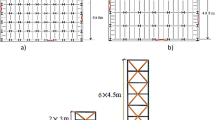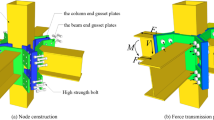Abstract
Proper modeling of the Hysteretic Damping (HD) capacity of structural models at a desired performance level is the key requirement for reliable estimation of design base shears in Direct Displacement-based Design (DDBD) method. Priestley and his colleagues on the basis of their research, have proposed a formula to predict the HD capacity of Steel Moment-resisting Frames (SMRFs) which is presented in DBD12. The current study examined this relation and proposes a reliable equation for design of SMRFs using DDBD method at the Life Safety (LS) performance level and the Equivalent Viscous Damping (EVD) hypothesis. For this purpose, a wide range of SMRFs were analysed using linear/nonlinear static/dynamic time history methods under different loading conditions. The damping ratios of all models were calculated using Jacobsen’s and Jennings’s formulas and the procedure proposed by FEMA-440. The results show an exponential trend that diverges from the empirical formula presented in DBD12. Two new relations are proposed for hysteretic damping based on ductility and the ratios of the initial and equivalent periods.
Similar content being viewed by others
References
AISC (2010). Specification for Structural Steel Buildings, American Institute of Steel Construction AISC 360-10, Inc., Chicago, IL, USA.
ASCE (2010). Minimum Design Loads for Buildings and Other Structures, American Society of Civil Engineers ASCE 7–10, Reston, Virginia.
ATC (1996). Seismic Evaluation and Retrofit of Concrete Buildings, ATC-40, Applied Technology Council, Redwood City, California, Vol. 1, USA.
Blandon, C. A. and Priestley, M. J. N. (2005). “Equivalent viscous damping equations for direct displacement based design.” Journal of earthquake Engineering, Vol. 9, No. 2, pp. 257–278, DOI: 10.1142/S1363246905002390.
Boulaouad, A. and Amour, A. (2011). “A displacement-based seismic design for reinforced concrete structures.” KSCE Journal of Civil Engineering, Vol. 15, No. 3, pp. 507–516, DOI: 10.1007/s12205-011-1009-z.
Calvi, G. M. and Sullivan, T. J. (2009). A Model Code for the Displacementbased Seismic Design of Structures: DBD09 Draft Subject to Public Enquiry, ISBN: 978-88-6198-038-9.
Cecilia, I., Timothy, N. and Sullivan, J. (2015). “Applicability of the direct displacement-based design method to steel moment resisting frames with setbacks.” Bull Earthquake Engineering, Vol. 13, pp. 3841–3870, DOI: 10.1007/s10518-015-9787-1.
Chopra, A. K. (2013). Dynamics of structures theory and applications to earthquake engineering, 4th edition, Lebanon, Indiana, U.S.A.: Prentice Hall, ISBN 10: 0-13-285803-7.
Dimopoulos, A. I., Bazeos, N., and Beskos., D. E. (2012). “Seismic yield displacements of plane moment resisting and x-braced steel frames.” Soil Dynamics and Earthquake Engineering, Vol. 41, pp. -140, DOI: 10.1016/j.soildyn.2012.05.002.
Dwairi, H. M. (2004). Equivalent Damping in Support of Direct Displacement-Based Design and Applications to Multi-span Bridges, Ph.D. Thesis, North Carolina State University, Raleigh, NC.
Dwairi., H. M., Kowalsky., M. J., and Nau., J. M. (2007). “Equivalent damping in support of direct displacement-based design.” Journal of Earthquake Engineering, Vol. 11, No. 4, pp. 512–530, DOI: 10.1080/136324606010 33884.
Esmaeilabadi, R. (2016). Improving the parameters of directly displacementbased design in steel moment resisting frames, Ph.D. Thesis, Science and Research Branch, Islamic Azad University. Tehran, Iran.
FEMA356 (2000). Prestandard and commentary for the seismic rehabilitation of buildings, FEMA356, in rehabilitation requirements, Federal Emergency Management Agency, Washington, DC, USA.
FEMA440 (2005). Improvement of nonlinear static seismic analysis procedures, Federal Emergency Management Agency, Washington DC, USA.
Gasparini, D. and Vanmarcke, E. H. (1976). “SIMQKE—a program for artificial motion generation, user’s manual and documentation.” Massachusetts Institute of Technology, Massachusetts, USA
INBCSD (2013). Iranian National Building Codes for Structural Design. Part 10: Design of steel buildings, Tehran, Iran.
Nievas, C. I. and Sullivan, T. J. (2015). “Applicability of the direct displacement-based design method to steel moment resisting frames with setbacks.” Bulletin of Earthquake Engineering, Vol. 13, No. 12, pp. 3841–3870, DOI: 10.1007/s12205-011-1009-z.
Powell, G. H. and Emeritus (2013). “Static pushover methods -explanation, comparison and implementation.” Retrieved from https://wiki. csiamerica.com
Priestley, M. J. N. (1993). “Myths and fallacies in earthquake engineering–conflicts between design and reality.” Bulletin of the New Zealand National Society for Earthquake Engineering, Vol. 26, No. 3, pp. 329–341.
Priestley, M. J. N., Calvi, G. M., and Kowalsky, M. J. (2007). Displacementbased Seismic Design of Structures. IUSS Press, Pavia. ISBN: 978-88-6198-000-6.
SeismosSignal ver 5.1.0 (2015). A Program Process Strong-montion data, URL: http://www.seismosoft.com/SeismoSignal/.
Shibata, A. and Sozen, M. A. (1976). “Substitute structure method for seismic design in R/C.” ASCE, Journal of Structure Engineering, Vol. 102, No. 1, pp. 1–18.
Standard No. 2800 (2014). Iranian Code of Practice for Seismic Resistant Design of Buildings, Standard No. 2800, 4th edition, BHRC Publication No. S-253, Iran, Tehran.
Sullivan, T. J., Priestley, M. J. N., and Calvi, G. M. (2012). A Model Code for the Displacement-Based Seismic Design of Structures (DBD12), ISBN: 978-88-6198-072-3.
Wijesundara, K. K., Nascimbene, R., and Sullivan T. J. (2011). “Equivalent viscous damping for steel concentrically braced frame structures.” Bulletin of Earthquake Engineering, Vol. 9, No. 5, pp. 1535–1558, DOI: DOI 10.1007/s10518-011-9272-4.
Author information
Authors and Affiliations
Corresponding author
Rights and permissions
About this article
Cite this article
Abadi, R.E., Bahar, O. Investigation of the LS Level Hysteretic Damping Capacity of Steel MR Frames’ Needs for the Direct Displacement-Based Design Method. KSCE J Civ Eng 22, 1304–1315 (2018). https://doi.org/10.1007/s12205-017-1321-3
Received:
Revised:
Accepted:
Published:
Issue Date:
DOI: https://doi.org/10.1007/s12205-017-1321-3




